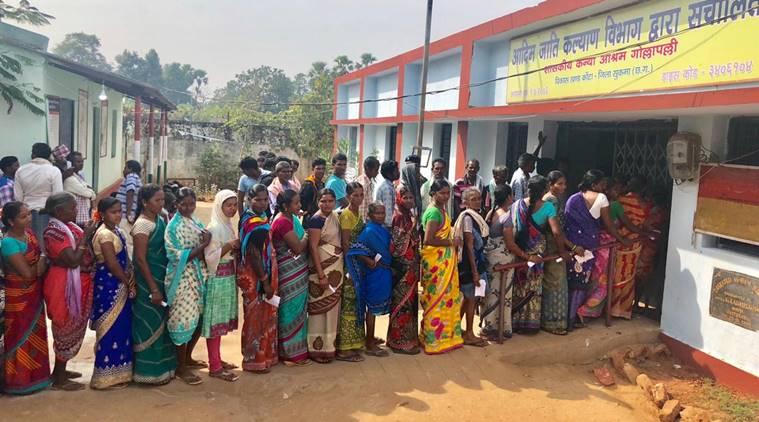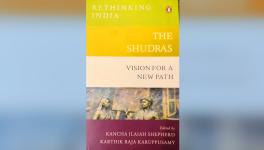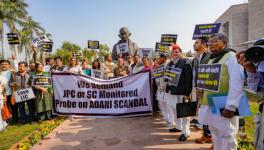Chhattisgarh: Who Is Going to Win elections?

Image Courtesy: Indian Express
Polling for the Chhattisgarh Assembly concluded on Tuesday. For the first time since the state was formed in 2004, the electoral battle was not a straight contest between the Congress and the BJP. This was because Ajit Jogi, former Congress chief minister, who quit his party in 2016, was leading a third front made up of his new party (Janata Congress Chhattisgarh or JCC), BSP and CPI. What can happen?
There are numerous possibilities, all depending on how many votes the third front gathers, and importantly, from which side – Congress or BJP. The riddle is complex, and political pundits are scratching their heads trying to figure it out.
Based on a Newsclick tool, which draws on data from past three elections as well as regional trends and rural-urban seats, alliances and swings can be analysed to arrive at an informed prediction for the results. This tool is available for anybody to use at the Newsclick website.
In Chhattisgarh, before you start using the Newsclick predictor, some key factors need to be recognised. Congress and BJP were pretty close to each other in terms of vote shares in the last Assembly elections in 2013. The Congress had 40.29 per cent votes, while the BJP got 41.04 per cent. Typically, in a straight fight, this meant that the seats won by each were not so close: Congress had 39 seats, while the BJP got 49. Note that BSP had a single seat, but got 4.27 per cent votes overall, while Independents and other parties had 14.4 per cent votes, but could not get any seat.
In this election, however, the main political factor is the BJP’s increasing unpopularity. After 15 years of continuous rule, the saffron party has lost its sheen; farmers are discontented at low returns to produce, and declining procurement at MSP; industrial workers are enraged at very low and stagnant wages while relentless attempts at privatisation of PSUs have made the BJP unpopular with state sector workers. Unemployment is rife. Government schemes are not being properly implemented due to cuts in funding or corruption. Land grab by corporate bodies, helped along by the state government, has angered Adivasi communities. Dalits are alienated because of hostility of the Sangh parivar, and the BJP’s culpability in dilution of the SC/ST atrocities law.
All this means that it is safe to assume that the BJP is going to slip downwards in terms of vote share. Let us assume that there is going to be a seven per cent swing away from the BJP, considering all the pent-up anger on the ground.
Where will these voters turning away from BJP go? That’s the billion-dollar question.
Scenario 1: Jogi cuts into BJP vote
Let us assume that these BJP voters are not comfortable voting for Congress, and they feel more attracted to the JCC-BSP alliance. If you input this swing in the Newsclick Predictor, the results are this: Congress sweeps the state with 63 seats, BJP is decimated getting just 23 seats, and JCC-BSP alliance has to be content with just 3 seats although their vote share shoots up from 4.3 per cent to 11.3 per cent.


Scenario 2: Jogi cuts into both BJP and Congress
It might be argued – with some merit – that Ajit Jogi’s outfit will not simply draw BJP supporters, but will eat into Congress votes as well. After all, Jogi was one of the Congress’ biggest leaders in the state. To understand what happens in this case, let us distribute the swing differently. Suppose, BJP loses seven per cent of its votes, and Congress loses another four per cent, all of which goes to the JCC-BSP alliance. Inputting this into the Newsclick predictor, it throws up a surprising result: Congress still wins comfortably, getting 46 seats, while BJP gets 39. JCC-BSP alliance still doesn’t make a big mark, getting just 4 seats although its vote share stands at over 15 per cent.

Regional Variations
The Newsclick election predictor tool allows one to study vote shares in different regions. In Chhattisgarh, the Northern hilly areas including Surguja, Bilaspur, Korba etc. had seen a larger vote share for BSP (6.12 per cent). So, it is in these areas that the combination of JCC with BJP is likely to make a bigger dent. Assuming a scenario 2 situation (BJP losing 7 per cent, Congress losing 4 per cent to JCC-BSP), the Northern areas of the state will see the Congress still gaining three seats to get 21 seats, while the BJP will lose 6 seats to go down to 13. BSP-JCC will gain 3 seats in addition to the sole seat they had earlier.

In the Central Plains of Chhattisgarh, BJP had led handsomely in 2013, getting 26 seats to Congress’ 13, and one going to an Independent. In the new scenario, the gap between the two big parties will narrow down with BJP losing four seats and Congress gaining four. This is also the area where Jogi has the most influence, but his alliance may not muster enough votes to make any dent, although all the other candidates combined will increase their vote share considerably from 17.35 per cent to 28.35 per cent.

In the Southern Bastar region, despite the massive swing gains by JCC-BSP, there will not be any change in the seats for Congress (8) and BJP (4).

In short, the much talked-about Jogi factor appears to be over-hyped, if one goes by past elections, and the assumption that there is anger against the BJP translating into an anti-BJP voting trend. This may change – as some are speculating – if the damage by JCC-BSP to Congress is more than to the BJP. What will happen in that scenario? Check it out at Newsclick’s election predictor.
Get the latest reports & analysis with people's perspective on Protests, movements & deep analytical videos, discussions of the current affairs in your Telegram app. Subscribe to NewsClick's Telegram channel & get Real-Time updates on stories, as they get published on our website.























